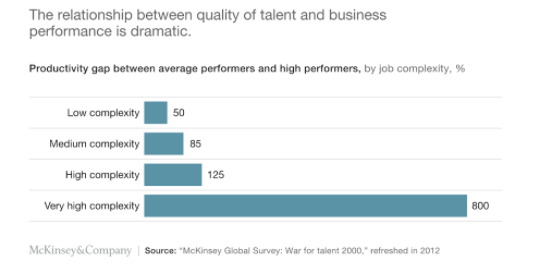
How companies can retain top talent
Employee retention is fast becoming a key competitive differentiator. A company’s ability to hold on to its talent — especially in tight hiring markets — has profound ramifications for its ability to operate at a high level, without the disruptions that employee turnover brings.
Every single organisation competes to recruit the best talent for their organisations. Why? The best workers do the best and the most work. But many companies do an awful job of finding and keeping them.
Superior talent is up to eight times more productive
It’s remarkable how much of a productivity kicker an organisation gets from top talent. A recent study of more than 600,000 researchers, entertainers, politicians, and athletes found that high performers are 400 percent more productive than average ones. Studies of businesses not only show similar results but also reveal that the gap rises with a job’s complexity. In highly complex occupations—the information- and interaction-intensive work of managers, software developers, and the like—high performers are an astounding 800 percent more productive.

As job opportunities become available, your employees, especially those feeling under-challenged and under-valued, may begin to seek out other options.
To ensure your best employees stay on board, we’ve put together a list of tips and tricks you can follow to retain top talent at your company:
Acknowledge a job well done
Gratitude and appreciation for a valiant effort and stellar product are critically important to employees’ willingness to give their best efforts.
Monetary bonuses are always nice, but recognition of a job well done goes a long way to creating good will and loyalty. Recognition needs to be specific: “Good job” is acceptable, but “Good job on the Nelson project” is better. In order to retain talent, you must make them feel appreciated, respected and worthwhile. Recent studies show that when employees feel undervalued and unappreciated, they look for other employment. They need to feel that their contributions to the business are important. But the feedback and praise must be sincere. Top talent is smart enough to know the difference between sincere appreciation and platitudes. If they get the same feedback for a run of the mill product and a superior product, chances are they are going to put in less time and effort every time and thus feel under-utilised and unimportant. Be thankful for your stellar performers’ top work.
While it’s important to reward a job well done, it’s just as important to address poor performance. You don’t want all your employees treated exactly the same way, as it may lead to top performers feeling underappreciated. Recognise your best performers, and work with low performers on how to improve their efforts to achieve greatness at your workplace.
Build a good company culture
One out of five Americans resigned from their workplace in the earlier five years due to toxic company culture.
Statistics have also shown us that:
- Nearly half of the employees (49%) have thought of leaving a company due to its toxic culture in the past five years
- A whopping 76% of employees said they recently had/have a toxic boss
- 26% of Americans dread going to work
A toxic workplace will cost your business a fortune, and it isn’t good for your employee’s mental health and well-being.
So what is company culture?
Company culture refers to the environment that defines how people work, behave, and interact. Is your working environment hostile? Or, is it a fun-loving environment that makes you pump-up to work with great enthusiasm?
We suggest the following concepts to consider:
Don’t be a “fun sponge”
If you want to ensure your employees are happy and eager to perform their best at your company, incorporate fun activities in the workplace. Fostering a fun work environment helps to keep your best people around, and makes your workplace a place your people look forward to coming to each day.
Regular team bonding activities
No man is an island. Whether you’re working in NGO or corporate firm, being a team player is vital since everyone works towards a common goal. Team bonding activity can help to foster the bond between co-workers, especially from different teams. It helps your top talent mingle and interact with other teams, promoting higher work engagement and work morale.
Help employees to feel a sense of ownership
It’s important to empower your employees to perform their best and show them that you trust them and their work. Ask for input from your employees. Help your employees to understand why they are being asked to perform the task at hand, and how it contributes to the success of the organisation.
Promote from within
Chances are, you have a number of employees who are qualified for various positions within your company and have been working for years in hopes of potentially being promoted. Provide your employees with clear direction and expectations for growth. Work with your employees to understand how they are working towards a goal (i.e., a raise, a promotion, a management position, etc.)
Know your company’s mission and values
Identify the most important skills and values for your company. Then fill positions around those needs instead of just hiring one employee to replace another.
“Candidates have a better time assessing their fit when you’re clear with your employer brand and values from the outset,” said Kim Stewart, SVP and director of talent management for First Citizens Bank. “Employees feel more engaged and are more likely to flourish when their values are aligned with those of their employer.”
A Forbes article on smart hiring strategies recommends knowing your company’s value proposition and your target audience. Recruiting is selling, so it’s important to understand your organisation’s selling points.
Be flexible
In the traditional workplace, it’s the norm that employees abide by the strict 9-5 working hours schedule. If you’re late to work, you’ll receive a warning letter from your HR team. Sometimes, your salary will be deducted automatically, despite having a legit reason for arriving late at work.
But, hey, we’re living in the 21st century! Flexibility is the key when retaining top talent. Strict working schedule and location is outdated. According to Global Talent Trends, 51% of employees wish their company offers a more flexible work option.
Stick with remote work options – employers in general will have to adopt this attitude if they want to keep their workers, experts say.
“The pandemic demonstrated that long-term remote work is possible,” says John Dooney, an HR knowledge advisor with the Society for Human Resource Management (SHRM). “From a recruitment and retention perspective providing increased flexibility for work hours and location of work help increase employee satisfaction, which leads to retention, along with increasing an employer’s competitiveness and attraction to land top talent.”
Equally important is a good old holiday. Vacation days are critical to your work force’s morale, wellness, performance, and productivity. By making employees feel uncomfortable taking their allotted paid vacation days, not only do you deny them some much needed R&R, but also encourage them to look elsewhere.
Offer good perks
About 60% of people reported that perks and benefits are essential when deciding whether to accept a job offer based on the Glassdoor survey in 2015. A similar survey concluded that 80% of employees would choose additional benefits over a pay raise. This is a clear indicator that salary and compensation alone are not enough to retain your company’s top talent.
Offering robust benefits options at a time when many employers are limiting them is a way to keep employees happy. Supplemental insurance policies, such as disability, cancer, and critical illness, allow employees to customise their benefits package according to their individual needs and lifestyle.
These policies can also help a variety of generational workers stay financially stable in the event of an unexpected illness or injury by paying cash benefits to help cover out-of-pocket costs so they can maintain their lifestyles. Even better, supplemental insurance can be offered at no cost to employers.
Invest in career growth
Time is a valuable asset for your top talent. As learning is a life-long journey, it’s essential that your top talent contribute, learn, and evolve with your company. If there’s no career progression, your top talent will most likely quit, as they do not want to waste their time.
It’s important for companies, especially growing ones that are looking to expand their workforce, to invest in their employees so they feel more confident about their future within the company. Workers who see their employers investing in their personal career development are more productive and less stressed about job security – making them happier.
This can be done by implementing one-on-one mentor partnerships or by providing employees access to career counseling professionals or development programs.
Provide opportunities to grow and learn, and let your employees know there is room for advancement in your company. Provide tuition for continuing education classes. Give challenging and stimulating work. Tap into their passion and allow them to focus their time and energy on projects they can enjoy. Let them know what career development plans you may have for them and what opportunities are available for them to grow with the company.
Be competitive
Try and keep up on what your competitors are doing to keep their employees happy. When possible, exceed the efforts your competitors are making. You want your employees to feel that your workplace is superior to others in the field. It will encourage them to stay and be grateful for the position they have rather than seeking other employers that seem to have more to offer.
The bottom line
Keeping top talent in today’s workforce is not an easy task, and what may have kept people in their jobs before, isn’t always the answer with today’s workforce. Therefore, it’s important for employers to continue enhancing their workplace culture and reinforcing the message that they care about and appreciate their employees.